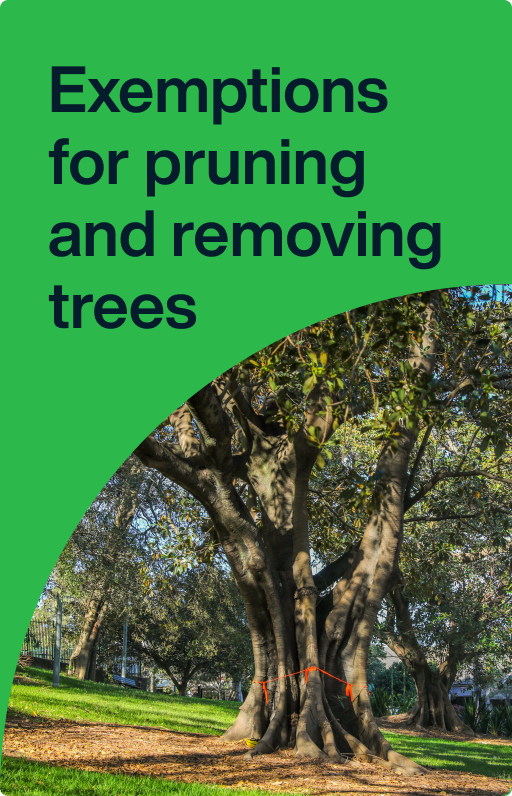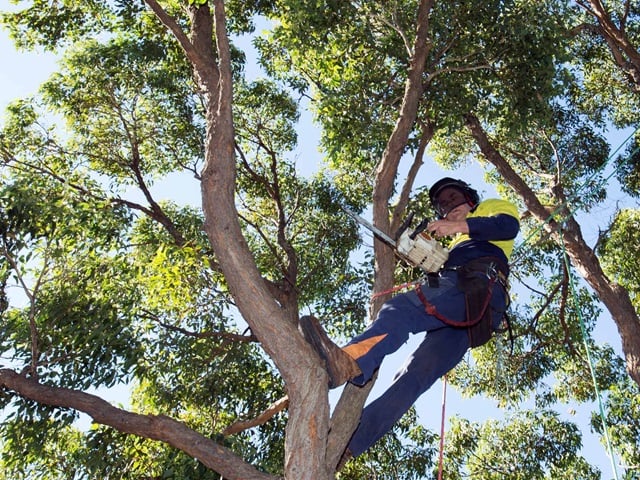Exemptions for pruning and removing trees
Permission isn’t required for some types of tree work, depending on the urgency, species or amount of work involved.

At a glance
- We must be satisfied a person with appropriate knowledge and expertise has identified the tree needs to be removed or pruned without our permission.
- It is important to read the tree pruning guidelines alongside the pruning exemptions
- View our step-by-step guidelines to understand better how to manage the process of responsibly removing or pruning a tree
To show the tree was in this condition, you must provide us with:
- a record of the tree's condition, including photographs detailing the issue
- the high and imminent level of risk the tree presented
- a statement verifying how current or future works were the minimum actions necessary to manage the risk.
You'll also need to provide a report from a qualified arborist with a minimum level 3 in arboriculture (AQF) before the works start, or immediately after for removal or pruning outside business hours.
When immediate action is required
The qualified arborist is responsible for identifying if the tree is a high and imminent risk to human life or substantial property. The arborist will identify if action is required within 48 hours.
Risks that are imminently dangerous may include:
- obvious instability of the root system
- evidence of soil heave or cracking
- loss of structural roots or root decay
- storm damage
- structural defects, such as splitting branches.
If we're not satisfied the tree was dead, is dying or poses an imminent risk to human life or substantial property, we may issue fines or pursue legal action.
A permit or development consent isn't required for trees exempt from the Sydney Development Control Plan 2012.
The following species can be removed without our permission unless the tree is listed on the register of significant trees or the heritage trees list:
- Ailanthus altissima (tree of heaven)
- Bamboo sp (all species and cultivars)
- Citrus sp (all varieties)
- Cotoneaster sp (Cotoneaster)
- Ficus elastica (rubber tree)
- Gleditsia triacanthos – not cultivars (wild honey locust)
- Lagunaria patersonia (Norfolk Island hibiscus)
- Ligustrum sp (privet)
- Melia azedarach (white cedar)
- Morus species (mulberry)
- Musa species (banana)
- Olea europaea var. Africana (African olive)
- Robinia pseudacacia – not cultivars (false acacia)
- Salix babylonica (willow)
- Schefflera actinophylla (umbrella tree)
- Syagrus romanzoffianum (cocos palm).
If the tree is less than 10m tall, the following trees can be pruned or removed without our permission unless listed on the register of significant trees:
- Cinnamomum camphora (camphor laurel)
- Celtis sinensis (Chinese nettle tree)
- Celtis occidentalis (American nettle Tree)
- Erythrina x sykesii (coral tree)
- Liquidambar styraciflua (Liquidambar)
Your obligations
Property owners are responsible for ensuring the tree species was listed as being exempt.
Identification should be obtained by a qualified arborist or horticulturalist with a minimum level 3 in arboriculture or horticulture (AQF).
Where possible, we suggest you keep photo evidence in case we make contact and you need to show the works didn't require a permit.
A permit or development consent is not required to prune a tree on private property if the pruning:
- provides clearances consistent with the tree pruning guidelines (see below) and the branch size does not exceed the diameter defined in each pruning category
- doesn't remove more than 5% of a tree's canopy
- does note damage or affect the health or structural stability of the tree
- is undertaken in line with the Australian Standard for the pruning of amenity trees and by a qualified arborist, minimum level 2 in arboriculture (AQF).
-
Major arterial roads
- Clearance permitted: 4.5m clearance in height measured from the road surface and in line with the kerb alignment
- Permitted branch size: Up to 100mm in diameter
-
Local roads
- Clearance permitted: 2.5m clearance over parking lanes and 4.5m clearance over roads, measured in height from the road surface and in line with the kerb alignment
- Permitted branch size: Up to 100mm in diameter
-
City pedestrian paths
- Clearance permitted: 2.5m clearance over footpath measured in height from ground level
- Permitted branch size: Up to 100mm in diameter
-
Domestic power or telecommunications lines
- Clearance permitted: Minimum clearance of 0.5m and a maximum clearance of 1m, measured from the service line
- Permitted branch size: Up to 50mm in diameter
-
Buildings
- Clearance permitted: Maximum clearance of 1m from any approved building, measured from the surface of the structural component (wall or roof) of the building's edge
- Permitted branch size: Up to 50mm in diameter
-


